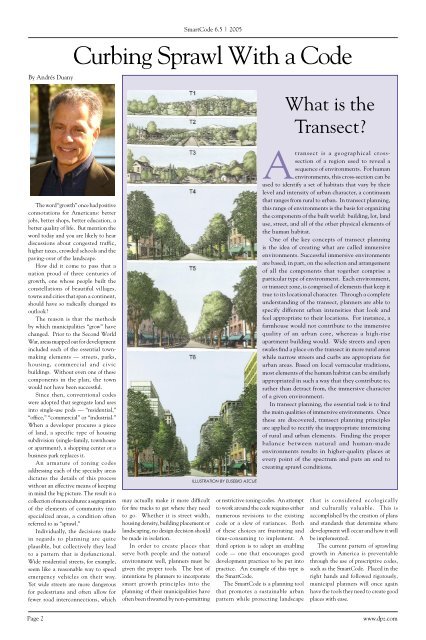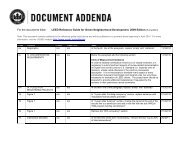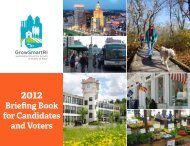SmartCode Summary Report
SmartCode Summary Report
SmartCode Summary Report
Create successful ePaper yourself
Turn your PDF publications into a flip-book with our unique Google optimized e-Paper software.
<strong>SmartCode</strong> 6.5 | 2005<br />
Curbing Sprawl With a Code<br />
By Andrés Duany<br />
What is the<br />
Transect?<br />
The word “growth” once had positive<br />
connotations for Americans: better<br />
jobs, better shops, better education, a<br />
better quality of life. But mention the<br />
word today and you are likely to hear<br />
discussions about congested traffic,<br />
higher taxes, crowded schools and the<br />
paving-over of the landscape.<br />
How did it come to pass that a<br />
nation proud of three centuries of<br />
growth, one whose people built the<br />
constellations of beautiful villages,<br />
towns and cities that span a continent,<br />
should have so radically changed its<br />
outlook?<br />
The reason is that the methods<br />
by which municipalities “grow” have<br />
changed. Prior to the Second World<br />
War, areas mapped out for development<br />
included each of the essential townmaking<br />
elements — streets, parks,<br />
housing, commercial and civic<br />
buildings. Without even one of these<br />
components in the plan, the town<br />
would not have been successful.<br />
Since then, conventional codes<br />
were adopted that segregate land uses<br />
into single-use pods — “residential,”<br />
“office,” “commercial” or “industrial.”<br />
When a developer procures a piece<br />
of land, a specific type of housing<br />
subdivision (single-family, townhouse<br />
or apartment), a shopping center or a<br />
business park replaces it.<br />
An armature of zoning codes<br />
addressing each of the specialty areas<br />
dictates the details of this process<br />
without an effective means of keeping<br />
in mind the big picture. The result is a<br />
collection of monocultures: a segregation<br />
of the elements of community into<br />
specialized areas, a condition often<br />
referred to as “sprawl.”<br />
Individually, the decisions made<br />
in regards to planning are quite<br />
plausible, but collectively they lead<br />
to a pattern that is dysfunctional.<br />
Wide residential streets, for example,<br />
seem like a reasonable way to speed<br />
emergency vehicles on their way.<br />
Yet wide streets are more dangerous<br />
for pedestrians and often allow for<br />
fewer road interconnections, which<br />
may actually make it more difficult<br />
for fire trucks to get where they need<br />
to go. Whether it is street width,<br />
housing density, building placement or<br />
landscaping, no design decision should<br />
be made in isolation.<br />
In order to create places that<br />
serve both people and the natural<br />
environment well, planners must be<br />
given the proper tools. The best of<br />
intentions by planners to incorporate<br />
smart growth principles into the<br />
planning of their municipalities have<br />
often been thwarted by non-permitting<br />
ILLUSTRATION BY EUSEBIO AZCUE<br />
or restrictive zoning codes. An attempt<br />
to work around the code requires either<br />
numerous revisions to the existing<br />
code or a slew of variances. Both<br />
of these choices are frustrating and<br />
time-consuming to implement. A<br />
third option is to adopt an enabling<br />
code — one that encourages good<br />
development practices to be put into<br />
practice. An example of this type is<br />
the <strong>SmartCode</strong>.<br />
The <strong>SmartCode</strong> is a planning tool<br />
that promotes a sustainable urban<br />
pattern while protecting landscape<br />
A<br />
transect is a geographical crosssection<br />
of a region used to reveal a<br />
sequence of environments. For human<br />
environments, this cross-section can be<br />
used to identify a set of habitats that vary by their<br />
level and intensity of urban character, a continuum<br />
that ranges from rural to urban. In transect planning,<br />
this range of environments is the basis for organizing<br />
the components of the built world: building, lot, land<br />
use, street, and all of the other physical elements of<br />
the human habitat.<br />
One of the key concepts of transect planning<br />
is the idea of creating what are called immersive<br />
environments. Successful immersive environments<br />
are based, in part, on the selection and arrangement<br />
of all the components that together comprise a<br />
particular type of environment. Each environment,<br />
or transect zone, is comprised of elements that keep it<br />
true to its locational character. Through a complete<br />
understanding of the transect, planners are able to<br />
specify different urban intensities that look and<br />
feel appropriate to their locations. For instance, a<br />
farmhouse would not contribute to the immersive<br />
quality of an urban core, whereas a high-rise<br />
apartment building would. Wide streets and open<br />
swales find a place on the transect in more rural areas<br />
while narrow streets and curbs are appropriate for<br />
urban areas. Based on local vernacular traditions,<br />
most elements of the human habitat can be similarly<br />
appropriated in such a way that they contribute to,<br />
rather than detract from, the immersive character<br />
of a given environment.<br />
In transect planning, the essential task is to find<br />
the main qualities of immersive environments. Once<br />
these are discovered, transect planning principles<br />
are applied to rectify the inappropriate intermixing<br />
of rural and urban elements. Finding the proper<br />
balance between natural and human-made<br />
environments results in higher-quality places at<br />
every point of the spectrum and puts an end to<br />
creating sprawl conditions.<br />
that is considered ecologically<br />
and culturally valuable. This is<br />
accomplished by the creation of plans<br />
and standards that determine where<br />
development will occur and how it will<br />
be implemented.<br />
The current pattern of sprawling<br />
growth in America is preventable<br />
through the use of prescriptive codes,<br />
such as the <strong>SmartCode</strong>. Placed in the<br />
right hands and followed rigorously,<br />
municipal planners will once again<br />
have the tools they need to create good<br />
places with ease.<br />
Page 2<br />
www.dpz.com







